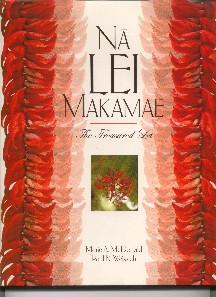Digital Collections
Celebrating the breadth and depth of Hawaiian knowledge. Amplifying Pacific voices of resiliency and hope. Recording the wisdom of past and present to help shape our future.
Marie A. McDonald and Paul R. Weissich
Lima hana maiau is a phrase descriptive of work done with the hands in a meticulous, loving manner—of work that belongs to a value system removed from western concepts of time, effort, and marketability. Although Nā Lei Makamae is a book with a price tag, it belongs unmistakably to the hana maiau tradition that we have come to associate with all of Marie McDonald’s handiwork. A quarter century after the release of her definitive Ka Lei, she succeeds again in providing us with a buke lei aloha of great beauty and significance.
Auntie Marie’s current volume, written in partnership with Paul Weissich of the Honolulu Botanical Gardens, covers more than eighty flowers and plants used in the making of traditional lei. These pua are arranged in alphabetical fashion, mai ka ‘a‘ali‘i a hiki loa i ka wiliwili. Each is photographed at least twice: as it appears in lei and as it is found in the wild. Each is accompanied by carefully researched botanical, geographical, and cultural information. And many are further enhanced by short mele composed specifically for this project by kumu hula Pualani Kanaka‘ole Kanahele.
The confluence, in Nā Lei Makamae, of lei, text, mele, place, and image is often so powerful that it brings us to tears. What, for example, could be more pono than a presentation of lauaʻe that includes an excerpt of Hi‘iaka’s oli lei at Nā Pali, a newly composed mele lauaʻe by “P.K.K.”, and a photo of Kahu Chandler and Haleakahau‘oli Wichman—kupa o Hāʻena—wearing lei laua‘e beneath the laua‘e-famed cliffs of Makana? Epiphanies of this sort arise, in great part, from the photography of Jean Coté, whose work is characterized by a refusal to adopt Reecian standards of Hawaiian beauty. No fine-art cheesecake here; just kānaka maoli in maoli contexts that render us all the more beautiful for all our imperfections.
